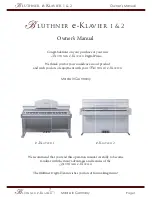
UNAOHM
46
EP2500 (Rev. 0)
10.2
Description of the MPEG Network Information Table (NIT)
If present in the DTS, on top you will see the name of the Broadcaster on one line and on the
following line the information regarding the satellite and transponder :
•
Orbital position in degrees followed by
E
or
W
(East or West).
•
Polarization with indication
LH
(Linear Horizontal),
LV
(Linear Vertical),
CR
(Circular
right) or
CL
(Circular Left).
It is to be noted that the data may not be reliable due to transmodulation, satellite trasnponder
relaying or other causes.
Following this is the list of available video or radio programs, taken from the NIT or Network
Information table, and a HELP for the operations that may be carried out. Each line consists of:
•
A sequential number.
•
The name of the channel.
•
The video PID.
•
The number of audio signals available.
If more than 15 lines are needed to list all the information, then data are available on the screen
in different displays which may be scrolled via the shaft encoder. When the shaft encoder is used
for such a task, frequency selection through it is overridden.
Figure 23 MPEG Network Information Table display
Broadcaster-encrypted (not free to air) programs are marked by an “E” close to the name of the
program.
NOTE
: it may happen that you are shown an “E” when the program received is actually free to air
(not encrypted) or viceversa. This is because broadcasters at times do not transmit programs as
declaired.
NETWORK INFORMATION TABLE
NETWORK NAME: MEDIASET
O/P 19.0E LH
BACK
001 I1
VID 3200 AUD 01
002 C5
VID 3201 AUD 01
003 R4
VID 3202 AUD 01
004 TEST
VID 3203 AUD 03
005 RDMT
AUD 01
005 PROGRAMMES ON THE NETWORK
UP/DOWN = (SHAFT)
















































